![Guest Post: A Passion for Primitive Dogs]()
by TMDT Team | Dec 7, 2015 | Training Methods
This is a guest post by professional dog trainer, Molly Sumner, CDBC, CPDT-KSA, CBATI. She is an expert when it comes to training primitive dogs and is generously sharing her top 5 tips with us today. She now runs a website for primitive dogs and their owners: https://www.couchwolves.com/
Each night I fall asleep never having to remember to set an alarm clock. As dawn breaks so does the silence. A dull “woooo” sound begins from the crates on the first floor. It slowly gets louder and more punctuated. Then a few more voices join in until my canine alarm clock is going full blast. They are trying to tell me, as they do every morning, that they are awake and would like to go out. The only time I get a vacation from this routine is when I am away at an obedience trial. This is not due to any lack of attendance on their part, because I’m the crazy trainer showing primitive dogs in obedience. In reality it is because the orchestra ring leader is snuggling in bed with me, and when he has bed privileges he doesn’t want to get up till around noon. Lazy bones.
 My husband and I share our home with 5 Shiba Inus, a Cattle Dog mix, a Tibetan Mastiff, and a New Guinea Singing Dog. This seems like quite the mix of dogs, but they have one very strong thing in common and that is their primitive nature. To be clear, what I mean when I say “primitive dog” is a breed of dog who’s ancestral primitive nature is still intact. These dogs weave through the traditional breed groups making a pretty tapestry of shapes, sizes, and histories. But when you break them all down, a similar independent, sensitive, wise old soul is back there, ready to tell you that they know better. Some examples of primitive dogs are Africanis, Akitas, Alaskan Malamutes, Armenian Gampr, Basenji, Canaan Dog, Carolina Dog, Chow Chow, Finnish Spitz, Norwegian Elkhound, Pharaoh Hound, Saluki, Samoyed, Shar-pei, Swedish Lapphund and this is just a few. This short list (A longer list is available at the end of this article) gives you an idea of the variety of shapes, sizes, and jobs these dogs have, and their close resemblance to their canine ancestors, and/or selective breeding that has maintained behavioral and physiological traits going back 1000-5000+ years.
My husband and I share our home with 5 Shiba Inus, a Cattle Dog mix, a Tibetan Mastiff, and a New Guinea Singing Dog. This seems like quite the mix of dogs, but they have one very strong thing in common and that is their primitive nature. To be clear, what I mean when I say “primitive dog” is a breed of dog who’s ancestral primitive nature is still intact. These dogs weave through the traditional breed groups making a pretty tapestry of shapes, sizes, and histories. But when you break them all down, a similar independent, sensitive, wise old soul is back there, ready to tell you that they know better. Some examples of primitive dogs are Africanis, Akitas, Alaskan Malamutes, Armenian Gampr, Basenji, Canaan Dog, Carolina Dog, Chow Chow, Finnish Spitz, Norwegian Elkhound, Pharaoh Hound, Saluki, Samoyed, Shar-pei, Swedish Lapphund and this is just a few. This short list (A longer list is available at the end of this article) gives you an idea of the variety of shapes, sizes, and jobs these dogs have, and their close resemblance to their canine ancestors, and/or selective breeding that has maintained behavioral and physiological traits going back 1000-5000+ years.
Life with primitive dogs is a little different than life with other breeds. I mean sure, they are all dogs. But life with primitive dogs isn’t an owner/pet relationship. It’s more like a roommate agreement. They have their particular wants and needs and if you fail to understand them and find a way to manage them, you will end up with a huge problem on your hands. As my husband likes to say, “You don’t train a primitive dog, you come to an understanding”, and he is absolutely right. Many times trainers label these dogs “untrainable”, “willfull”, “stubborn”, or “dominant”. These labels only come out when a trainer or owner is butting heads with these dogs and their truly honest temperaments. I call it an honest temperament because they are utterly consistent and expect the same from you. They are strong communicators who will use a wide range of calming signals to express themselves. Trainers and owners who ignore them, many times end up on the frustrated end of the leash, or worse, bitten and bloodied.
In no way am I suggesting that primitive dogs are a greater bite risk or more aggressive than other breeds. However, I do believe that their tolerance for rude handling, compulsive training, and rude interactions with other dogs, is significantly less than breeds bred to be more tolerant. We created these breeds prior to the great Victorian genetic manipulation period and were never expected to be the center of attention in a family setting. Instead these dogs had a purpose to either hunt and kills other animals, guard property, pull, or herd. When not in use, these dogs were left to their own devices. They have an innate knowledge of what they want to be happy and usually a good chunk of that is to be left alone. They are also highly sensitive dogs and become intolerant of discomfort quickly. Enough repetitions of this and they will become unwilling to cooperate and eventually aggressive.
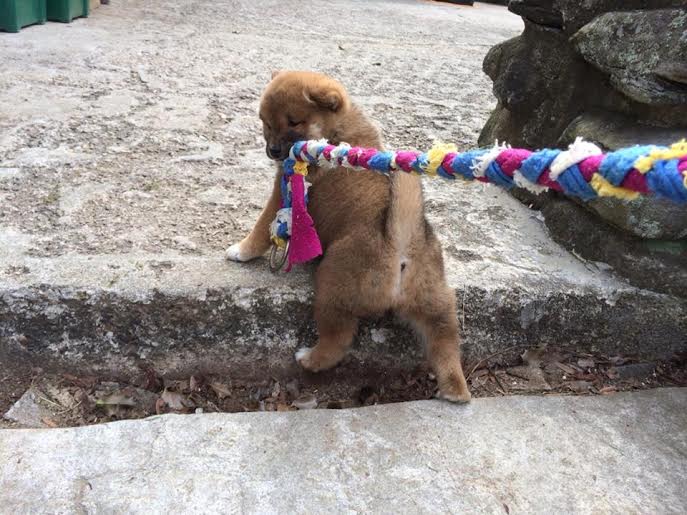
Today there is a growing population that enjoys breeds with these independent natures and it is becoming more and more important that trainers become familiar with how to be successful working with these kinds of dogs. I have clients come to me all the time telling me that their previous trainers hated primitive dogs, that they all are highly aggressive, or if it didn’t respond to compulsion based training, it couldn’t be trained. This is heartbreaking for an owner to hear and leads to many of these dogs getting dumped in shelters or left to an existence locked in a laundry room or outside kennel. It is the responsibility of modern progressive dog trainers to embrace the growing interest in these dogs and better understand their behavioral workings, motivations, and needs. Once these are met, owning, managing, and training these dogs is a breeze.
5 Tips for Training Primitive Dogs
1. If The Dog Is Failing – It’s Not Them, It’s You
Sorry but primitive dogs are very honest dogs. This means that if you’re rate of reinforcement is poor or you’re either too challenging or not challenging enough, a primitive dog will blow you off. The more this happens, the less they will want to interact with you and their relationship will continue to diminish until they actively avoid you. Keep training light, short and be ready to jump 2 steps ahead at any point. More than 5 or 6 repetitions is enough to bore most of these dogs and if they make a learning leap go with it. Don’t push them backwards or they will think your “game” is stupid and walk away.
2. You Can’t MAKE a Primitive Breed Do Anything
Molding a primitive dog just teaches the dog to avoid contact with you. Luring teaches the dog to sniff out treats before they are willing to work with you. Shaping and capturing tend to be the most powerful ways to train a primitive dog. They are very intelligent and when given the opportunity to work out operant tasks they will usually rise to the occasion very quickly. But this works both ways. If they know growling and biting is the only way to make you stop doing something they don’t like, they will stop communicating with calming signals and move to lunging whenever they perceive discomfort. If lunging doesn’t stop the discomfort they will escalate to biting. This is why knowing body language and teaching advocacy for what the dog is saying, is essential to a happy primitive dog household.
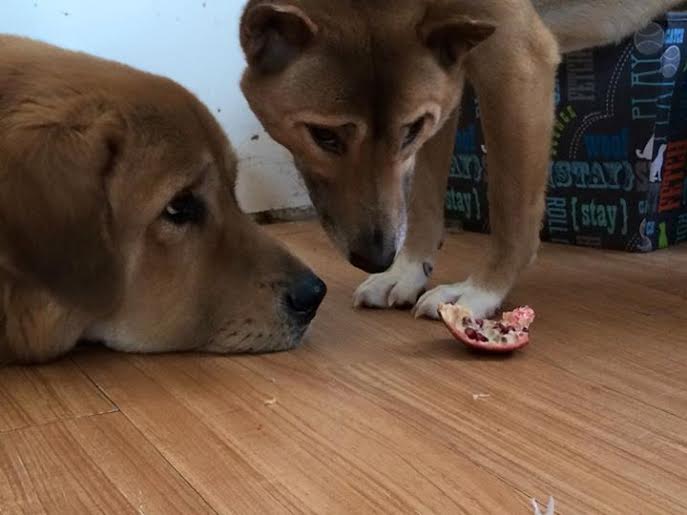
3. They Know You Better Than You Do
Primitive dogs are always watching and always working out the system. Every move you make and every gesture has been worked out in their heads. They know the difference between a recall that is for reward and a recall that is for the end of play because it is time to go to work. They know when you have a treat and when you don’t. These can lead to frustration for the owner when training “only works when a cookie is present” as well as Separation Anxiety, Resource Guarding, aggression while being handled, and leash reactivity. When called in to deal with behavior problems it is essential that a trainer see all the details prior to a problem situation to see what the dog is actually being cued by. It may be leagues away from where the owner thinks the cause is.
4. Self Interest is Your Guide
In my home I use very colorful terms of endearment with my dogs. It is an affectionate joke. But for many owners it is no joke. It is hard for many owners to get over the sense of self interest these dogs possess. Like I mentioned earlier, these dogs are more your roommate than your pet. These dogs, while they love you, are still out to get whatever it is they want, at whatever means necessary. But this is a powerful tool for trainers. Following methods like Karen Overall’s Deference Protocol, and other styles of, you get what you want, when I get what I want can create very harmonious households. I like to think Premack was channeling a primitive dog when we wrote his Principle because that will get you farther than anything else in your training.
5. Keep Your Heart Open
You can’t get mad at these dogs. They will simply walk away, go pee on something, and take a nap. You have to roll with the punches, appreciate their independent nature, and laugh at your mistakes. Otherwise these dogs will get inside your head and drive you insane. You will need multiple ways to train a behavior and don’t be afraid to start with classical conditioning. Most of the time the reason these dogs are challenging is because they are uncomfortable emotionally, not because they are dumb, wild or stubborn.

About the Author: Molly Sumner CDBC, CPDT-KSA, CBATI
Molly Sumner is a professional dog trainer and behavioral consultant. She lives in Frenchtown, New Jersey with her husband and house filled with primitive dogs, including Journey the worlds first competition titled New Guinea Singing Dog. Molly is the author of multiple articles for Barkpost, as well her blogs and loves giving voice to both her canine and human clients. She is currently working on book about primitive dog training and ownership. You can visit her blog at www.kindredcompanions.com or find her on Facebook.
Additional Resources for Dog Training Primitive Dogs
Reading:
Tools:
Dog Training Business Tips
Receive valuable dog training business tips and resources right in your inbox! Subscribe to The Modern Dog Trainer now by submitting your name and email below. Don’t forget to let us know what you want to learn more about!
![Guest Post: A Passion for Primitive Dogs]()
by Liz Wyant | Nov 23, 2015 | Training Methods
We know that dogs communicate with us all of the time, whether we notice it or not. However, can they let us know when they have learned a skill we are teaching? Stanley Coren says yes, in his article, “Does A Dog’s Body Language Tell Us How Much He Has Learned?”
The Seed Is Planted
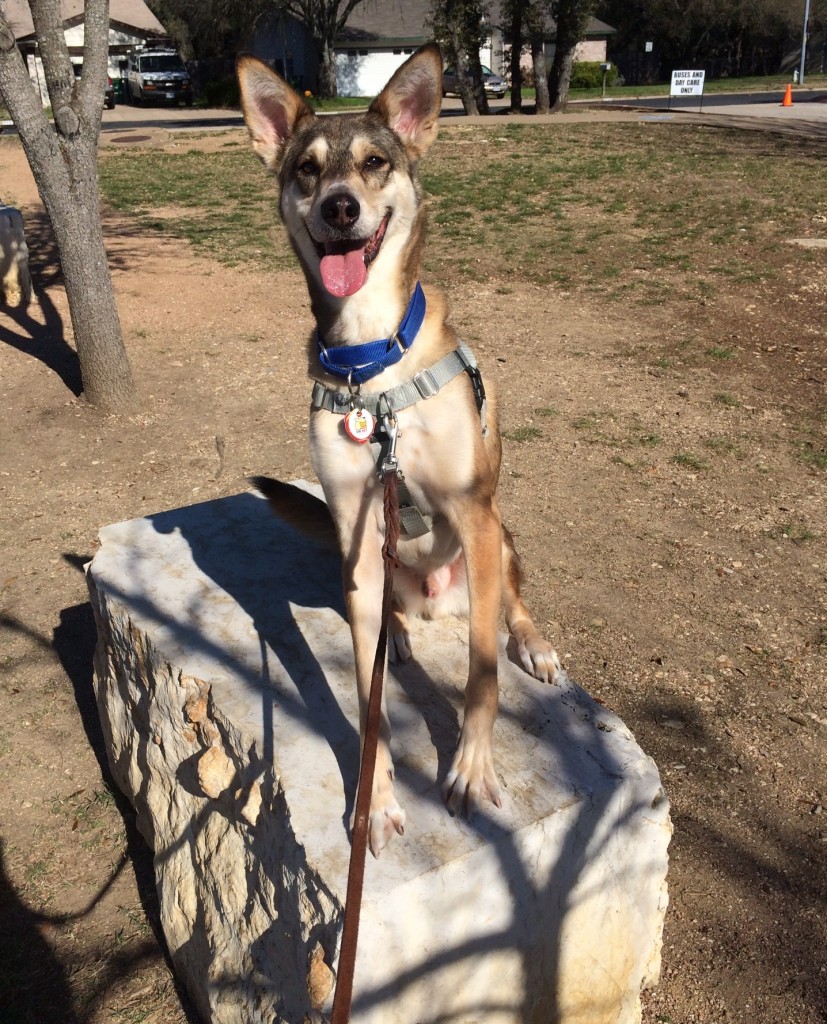 Coren began paying attention after a dog trainer mentioned that he noticed his dogs almost exhibited pushy, “dominant” behavior when they started to catch on to a new behavior. Instead of lolling tongues and wagging tails, the ears would go forward and tails up.
Coren began paying attention after a dog trainer mentioned that he noticed his dogs almost exhibited pushy, “dominant” behavior when they started to catch on to a new behavior. Instead of lolling tongues and wagging tails, the ears would go forward and tails up.
One he started paying attention, Coren began noticing this as well, mostly in dogs that were relatively new to learning. He then found a Japanese study that had looked into this premise. It was a team from the Azabu University School of Veterinary Medicine and was headed by Masashi Hasegawa.
The Study
The study involved 46 dogs with no prior obedience training. The goal was to teach them to sit using just a hand signal. They used luring – moving a food treat from in front of the dog’s nose to over their head to lure them into a sit. The sessions were 5 minutes long and documented via video. Video was also taken of the dogs during non-training times to compare behaviors. The videos were then scored, focusing on the ears, mouth, eyes, tail carriage, and wagging.
The Body Language Results
Mouths: Successful dogs were more prone to keeping their mouths shut, generally a sign of focus and concentration.
Ears: Successful dogs would have their ears rotated forward which is, again, a sign of focused attention.
Eyes: Successful dogs had wider than normal eyes, especially when staring at their trainer.
Tail: Successful dogs generally held their tail high and still, or vibrating slightly.
Is It Dominance?
Coren feels that “dominance” is too strong of a word for the behaviors exhibited. He feels that the successful dogs are showing strong, confident behavior once they have figured out the task. They get bolder and more pushy once they have “solved” the problem, and they want to keep training to continue earning treats.
Impact For Modern Dog Trainers
So what does this mean for you, as a modern dog trainer? We generally consider closed mouths, forward ears, and high, barely moving tails as signs of intensity and possibly nearing their threshold, so we often try to take things down a notch when we see these occurring. You will need to keep in mind that if you are training a green dog, or teaching a brand new skill, these behaviors may pop up and you should celebrate them. The dog is telling you she’s got it! Obviously, everything needs to be kept in context – if you are working with a reactive dog outside, he MAY be going over threshold. So it will be up to you to monitor the surroundings and take in the big picture.
Have you noticed these behaviors in any dogs that you’ve been training? Tell us about it!
Dog Training Business Tips
Receive valuable dog training business tips and resources right in your inbox! Subscribe to The Modern Dog Trainer now by submitting your name and email below. Don’t forget to let us know what you want to learn more about!
[mc4wp_form]
![Guest Post: A Passion for Primitive Dogs]()
by Lisa | Nov 17, 2015 | Events, Training Methods
No, not the dog. The Border Collies I’m talking about are people who volunteer to help at the Association of Professional Dog Trainers’ Annual Educational Conference & Trade Show. They are integral to the smooth and successful running of these Conferences.
2015 APDT Conference Border Collie Volunteers
They assist in rounding up and herding folks to the right sessions, assisting during demos, checking names tags at the door, answering questions, showing people to their seats, and helping during breaks.

The start of the BC Orientation Meeting with Carlos Betancourt, a co-host, on the far left standing, standing reading his notes
Being a member of the Border Collie Brigade provides you with the opportunity to meet new and interesting people, form new friendships, and enjoy the satisfaction of a job well done.
Bill Hatherley, the Border Collie Lead on the APDT Task Force says – “We like to say it is our privilege to help the attendees have a great conference experience. While it may not be noticeable, a lot of oversight and management was done in the months leading up to the Conference. Irma Bice, Neil Smith and I had been planning for and working on this conference since March of last year. We met every two weeks via conference call and coordinated our efforts.”
This year, there were 42 volunteers, with 19 of them being veterans who have been Border Collies for 10 years – now THAT is dedication! We even had some BCs take on 6 assignments. Wow!!!
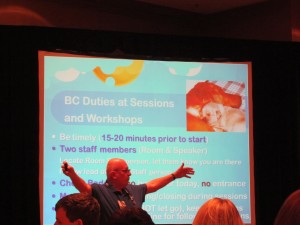
Bill Hatherley, BC Lead, giving the Duties of the BCs
The rest were at their first conference and wanted the opportunity to help and to network. We worked hard at providing them opportunities to meet new folks and everyone I talked to was very happy with this.”
Bill is very much like a cheerleader, he and Carlos Betancourt hosted the Training Meeting of the Border Collie Brigade. Between the two of them, they got the BCs excited and enthusiastic about their role. This great attitude carried on throughout the conference, helping all attendees to enjoy it even more.
I so wanted to be a BC, but my duties of reporting and blogging for The Modern dog Trainer took precedence. I chatted with some Border Collies – Jolynn Payne, Theresa Hyatt Cahill and Ryan Lockard and asked them some questions about their experiences.
1. Was this your first time being a BC?
- Jolynn – “It was my first year.
- Theresa – “First time.”
- Ryan – “This was my first time as a BC.”
2. Why did you volunteer as a BC?
- Jolynn – “I was at the conference a day early so I wanted to help and get involved.”
- Theresa – “Thought I’d get a better understanding and learning from other trainers. I did.”
- Ryan – “I volunteered because I like being involved and helping.”
3. Will you volunteer to be a BC again?
- Jolynn – “Absolutely!”
- Theresa – “YES I would volunteer again.”
- Ryan – “I would volunteer again.”
4. What was your best experience of the Conference?
- Jolynn – “Meeting new friends!”
- Theresa – “Best I found was that there was a lot of help getting started. A lot of helpful info and useful info building my business”
- Ryan – “The best thing was the positive comments that I received from the conference staff and the people I got to meet.”
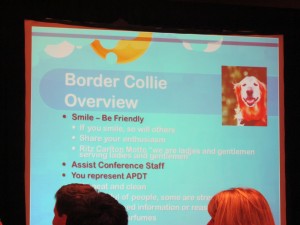
5. What was the worst experience you had being a BC?
- Jolynn – “Having to BC in a session where the speaker kept repeating “ok” after every sentence. Stopped counting after 35 in the first 30 minutes.”
- Theresa – “There wasn’t enough communication. I met a few trainers but other than that I was on my own to find info – who and how to contact someone if you were available for other things, where to go if I had a comment or complaint. The ones that have been there before welcomed me but I had so much free time and I didn’t know where to turn to offer any help if someone needed it. But everything worked out because now I know who to look for and where (for the most part) to go if I don’t.”
- Ryan – “The worst thing was the bag stuffing; it seemed to be very unorganized.”
6. What the duties did you volunteer to do?
- Jolynn – “I worked the check-in shirt table and 2 different sessions checking badges and watching doors.”
- Theresa – “I greeted and directed attendees”
- Ryan – “My duties were to verify attendees had paid for the day, that they were eligible to attend the workshop and to do the necessary head counts.”
Bill Hatherley, the BC Lead welcomes constructive comments and got lots of feedback from the volunteers, all to make things better and more efficient in the following years.
The BCs got special buttons, a BC ribbon on their lanyard, and a free APDT Conference shirt if they volunteered for 3 or more sessions. They also were invited to a yummy breakfast especially for them.
The next APDT Conference will be in 2016 Conference in Las Vegas. Consider sharing a few hours of your trip to help out as a volunteer Border Collie! Their contribution is invaluable and greatly appreciated.
Dog Training Business Tips
Receive valuable dog training business tips and resources right in your inbox! Subscribe to The Modern Dog Trainer now by submitting your name and email below. Don’t forget to let us know what you want to learn more about!
[mc4wp_form]
![Guest Post: A Passion for Primitive Dogs]()
by Liz Wyant | Nov 15, 2015 | Training Methods
With winter coming upon us, it is more important than ever to encourage your clients to evaluate how their dogs ride in the car. Many of our clients are perfectly content to allow their pooch to roam freely around the car, or even sit in the driver’s lap or on the windshield while the car is in motion. Though some think this is harmless and makes for cute pictures, all it takes is a split second for the client and their dog’s lives to get impacted forever.
Car safety cannot be emphasized enough with clients. As modern dog trainers, it is up to you to emphasize safety in all aspects of dog’s lives, not just immediate training needs. As somebody who has spun off the road with my dog in the car (fortunately we were both buckled in so did not get injured), car safety is a high priority. So what are options for car safety, and what behaviors does a dog need to know?
Car Harnesses

Photo courtesy of Liz Wyant
Harness are probably the easiest, most cost-efficient and space-saving option for most dog owners. A good harness will be wide across the chest and fully cover the chest down to the girth, but without hindering the neck or shoulders. It will have some padding and solid metal hardware. There are generally two main attachment points for car harnesses – either a metal hook that attaches to a sturdy strap and carabiner (as pictured below), or a loop that the car’s seatbelt will go through before being latched. Either way, the dog should be able to sit, stand, or lie down, but not be able to roam around. If they can move too far, that means they will not be as secure in case of an accident. Look for harnesses that have actual safety ratings. The harness in these pictures is Kurgo’s Tru-Fit Enhanced Strength Harness.

Photo courtesy of Liz Wyant
What behaviors should the dog know?
- The dog should be happy about wearing a harness, especially one that has a little more coverage than most walking-type harnesses.
- The dog should be able to sit quietly in one place without panicking. If the dog is spinning around, they can get tangled in the harness and injure themselves while also distracting the driver.
- The dog should wait to be invited into the car, and also should wait to be invited OUT of the car.
Crates
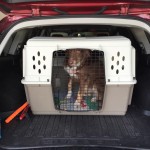
Photo courtesy of Laurie Schlossnagle.
A solid, well-secured crate will be safer than a car harness as it will not only keep the dog from being flung around the car, but it will keep other flying items from impacting the dog. The best of the best when it comes to car-specific crates is the Mim Variocage. However, as these are rather pricey, they are out of limits for most people. The next best is a variokennel or wire crate that is, again, properly secured to the car. A crate will be no use if it can go bouncing around the car because it is not secured. You want to make sure it’s just big enough for the dog to fit comfortably, but not spacious enough for them to be able to sprawl out and have oodles of room. Again, the goal is car safety and keeping them secure in case of an accident.

Photo courtesy of Amie Glasgow
What behaviors should the dog know?
- The dog needs to be crate-trained so they do not panic when placed in the crate.
- The dog should know how to chew appropriately provided toys/bones instead of fussing with the straps securing the crate to the vehicle.
- The dog should wait to be invited into the car, and also should wait to be invited OUT of the car.
What NOT To Do
- Allow the dog to hang his/her head out the window – Even at slow speeds, debris is kicked off the road by other vehicles and may severely injure the dog.
- Allow the dog to ride on the driver’s lap – A dog in the driver’s lap is incredibly distracting for the driver. And if there is a car accident, there is a high likelihood the airbag impact will kill the dog.
- Allow the dog to ride on the dashboard – In the case of an accident, a dog riding on the dashboard has very little chance of escaping unscathed. Also, they will hinder visibility and act as a distraction for the driver.
- Use a collar and leash to secure dog to headrest or other part of car – in case of an accident, all that pressure suddenly pulling on the dog’s collar will cause SERIOUS injury.
- Fail to have identification on dog – If there is an accident, and your dog manages to get loose, it is imperative that they have a collar with tags on so they can be quickly reunited. Microchips are wonderful, too, but only as backup to a collar and tags.
What tips do you have for car safety for dogs?
Dog Training Business Tips
Receive valuable dog training business tips and resources right in your inbox! Subscribe to The Modern Dog Trainer now by submitting your name and email below. Don’t forget to let us know what you want to learn more about!
[mc4wp_form]
![Guest Post: A Passion for Primitive Dogs]()
by Lisa | Nov 11, 2015 | Events, Training Methods
As a first time attendee of the 2015 APDT Annual Educational Conference & Trade Show, I was known as a “Conference Puppy” and I was thrilled to bits to travel all the way from Barbados to Dallas, Texas, USA to gain knowledge about dog training, behaviour and the business aspect of the dog industry.
Another important part of this conference, for me, was the networking. It was wonderful to meet my Facebook friends – Casey Lomonaco and Robin Bennett of the APDT’s Board of Trustees; guests I had on my Chat Time Interviews – Roger Abrantes, Michael Shikashio, Grisha Stewart and Josh Pitts; my Texan friends Abby Merlot, Jolynn Payne, Kevin Glowski, and my roommates Cheri Spaulding and Karen Reilly and so many others. Greater bonds of friendship have been made by spending our free time together and I truly value meeting them in real life.

Part of the gang networking at the Draft Lounge Catherine Steinke, Jolynn Payne, Carlos Betancourt in front, Cheri Spaulding, Kevin Glowski, Lisa White at the back.
The Sheraton Dallas Hotel, located in downtown Dallas, was huge, with lots of walking to get around. It was beautiful and the staff very friendly and helpful. The food was good and I ate from a variety – Peets was great to grab yummy Starbucks coffee (loved the Pumpkin Spice Latte) and a quick bite; I had the buffet breakfast at the Kitchen Table Restaurant, which had such a variety to choose. Most of the socialising was done at the Draft Media Sports Lounge. It was the perfect atmosphere with great music but you could still have a conversation, watch sports on their large screen TV’s, or play pool.
I found the schedule of things to do and see to be completely filled each day. The APDT even had an early meetup – AM Riser, Get to know your Neighbourhood Walk, from 7 – 7.45am. Errm I like my bed so that was too early for me and I didn’t make those meets. LOL.

Dr Stephen Ledoux and I
On Wednesday, day 1, the keynote speaker was Dr. Stephen Ledoux. He gave a talk about, “Helping Our Canine Friends By Helping Ourselves With Science.”
Each day from 8am to 5pm, there were the Live Animal Workshops. You could also choose the General Sessions which consisted of four Shorts to choose from, where speakers talked on a variety of topics for 45 minutes. They ran from 8 to 8.45, 9 to 10.30, and 10.45 to 12.15.
Lunch was an hour and a half, but even during lunch there were roundtable discussions and demos of freestyle, Hollywood dog or you could browse the vendors at the trade show.
The presentations started back from 1.30 to 3pm and again at 3.15 to 4.45pm. Thankfully there were breaks of 15 minutes to get to the other presentations and stretch your legs.
Even after the speakers presentations, there was still something to see and do from 5 to 9.30pm – Toy Making, Scientific Poster Session, more doggy demos and on Friday night was the APDT Foundation Reception and Auction which was great.
There were 3 tables full of mostly doggie items to bid on, ranging from dog toys, collars, personal sessions with Roger Abrantes and Sue Steinberg to name a few, as well as trips to the Caribbean. There were hors d’oeuvres and music, to which I danced a lot and managed to get the DJ to play some good modern pop music.
On the last day, Saturday, I was very sad, knowing this was the last day I would see my friends for another year and I was all teary eyed. Roger Abrantes gave a wonderful closing talk on, “Animal Training My Way,” which touched on our relationship with animals – bonds and respect.
“All we need do is control ourselves, our thoughts, our emotions and our behavior. If we do it correctly, we will produce the changes in others that exist, not against their will, not by force or manipulation of the truth, but because they want they want it.” – Roger Abrantes
If I had to choose who was the best speaker, it would be extremely difficult. A lot of interesting information was shared, some I already knew a bit about, so it was good to get it explained further and I also learnt new things.
However, where I think I truly benefited was in the business topics, since we dog trainers tend to want to learn everything we can about dogs, but neglect the business/marketing side of things.

Veronica Boutelle, myself and Gina Phairas of Dogtec. They are really nice folks.
My favourite speakers were the Dogtec duo – Veronica Boutelle and Gina Phairas, who had a variety of presentations – Newsletter Marketing, Start Your Business On the Right Paw, Put More $ In Your Pocket, and more. It was great to meet them and they are as nice in person as they were to deal with, when I was so fortunate to have won the APDT 2013 Business Makeover.
Overall, I found everyone to be friendly, even the Ph.D’s, those brainy folks, were nice and humble. They didn’t talk down to you at all and the “famous” folks, the big names who have written books or put out DVDs, were quite welcoming. I didn’t encounter any snobs there at all, no one thought they were better than others. It truly was a great atmosphere.
Oh, here are some tips for those attending conferences that I learnt the hard way –
1. Wear warm clothes, as it seems the powers that be like to keep you cold which apparently keeps you alert. I just shiver and quake.
2. Don’t overpack. Most people wear the same clothes from morning till night and it’s usually casual – jeans, shirt, sweater. Less clothes, means more room for dog books and toys. Oh and take a portable scale for your luggage; you don’t want to be overweight from all the goodies you buy and pay extra for your luggage.
3. Wear comfortable shoes since you will be walking all over the hotel, with warm thick socks. I made the mistake of wearing boots with heels the first day and my feet hurt from all the walking I was doing. Lesson learnt. I then wore my fluorescent orange sneakers everywhere. A friend said, “if you cannot find Lisa, just look down at the shoes.”
4. Have extra batteries and/or chargers. In one day my camera, cell and laptop died, grrrrrrr.
5. If allowed, take lots of pictures instead of writing notes from the Powerpoint Slides, you will always miss something. And put your camera on silent, so as to not disturb others.
6. Be organized. Know which speakers you want to see and print out the daily schedule in advance, so you are organized. Most hotel rooms don’t have free wifi, so you won’t be able to access the website.
7. If the Conference has an app, download it. This is very useful, since it has all the info about the Conference on it.
8. If you are traveling from another country, like me, phone calls and texts will be charged at an international rate, so it will be expensive. If possible, buy a SIM card with data. You can get one at the airport, but it would be cheaper from a local store.
9. Know where the Speakers will be located and how to get there. You will probably still get lost (I did, many times), but you can always ask others and follow them.
10. Get out there and talk to people; no sense in being a wallflower. Conferences are a great opportunity for networking, to meet new people, to exchange ideas, to make contacts with people in the industry. And DO remember to bring business cards and exchange them with other people.
With such a great experience at the APDT 2015 Conference, will I be attending future Conferences? HECK YEAH!! I am already planning on going to next year’s conference in Las Vegas.
Hope to see you there!
Dog Training Business Tips
Receive valuable dog training business tips and resources right in your inbox! Subscribe to The Modern Dog Trainer now by submitting your name and email below. Don’t forget to let us know what you want to learn more about!
[mc4wp_form]
![Guest Post: A Passion for Primitive Dogs]()
by Kat Camplin | Nov 5, 2015 | Training Methods
Semi-private lessons are my new favorite type of service. They cover a number of client “problem” areas that we don’t always get the opportunity to address through private instruction or group classes.
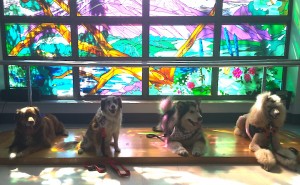
- Image via Kat Camplin
What Is A Semi-Private Lesson
Technically, the definition should be fairly obvious. A semi-private would assume that it’s more than one client and less than a regular group class. How you market it determines how it’s viewed.
The Smaller Class
Reactive Rover classes are typically smaller in size, but aren’t really sold as semi-private instruction. This is probably due to the classes taking place in a facility that does other group classes. Marketing a group class as “smaller,” or semi-private allows you to charge more per person per class to make up the income difference you’d normally have in a regular sized class. The smaller class should be no more than 3 or 4 students to make it exclusive. There is a balance with these classes. They have the opportunity to fill up quicker, but you need people with the income to pay more. Sales points can be “more one on one instruction,” or “great for shy or timid dogs.”
Try a few different naming conventions to see which one resonates with your target demographic.
The Group Private Lesson
Private instruction is usually geared for people who can’t make a group class or may have a dog that doesn’t do well away from home. The downside of having a dog trainer show up at your home is it costs more than going to a facility for a group class. If a new client can’t afford your private rate, giving them an option to host a small group at their home and split your rate with friends.
The upside of this type of semi-private is the client fills their own class from their neighbors and friends. The neighbors and friends get to split your private hourly rate and get one on one instruction. This works if all the students have basically the same needs. If one dog is reactive and the others just need basic obedience instruction time will probably not be in balance.
To make these work you really need to be upfront and inclusive to everyone involved. Topics and behaviors covered, the number of weeks the class meets, and what happens if someone can’t make a class should be spelled out in advance. A questionnaire can be helpful to see what everyone’s needs are and find the behaviors that cover the most problem areas. To save you time you’d want to be sure you have handouts and homework for what the lessons cover. The really great thing about doing these “neighborhood classes,” is that neighbors get to work with each other in between sessions, which increases client compliance and time spent training.
If you’re marketing these as a cost saving plan you’d split your hourly rate by the number of students then multiply it by the number of weeks. As an example: Your hourly rate is $100. There are three students in the semi-private class that runs for five weeks. Each student pays $34 a week, for a total of $170 per student. Typically these are run as a package, so payment is expected from each student up front.
Is it worth it? Yes, if you pick the right location. I am interrupted at least once in every neighborhood class by a neighbor that needs a trainer. It’s great exposure, just pick the right neighborhood.
Moving Advanced Clients To Semi-Private Lessons
Semi-rivate lessons are a fabulous way to continue to work with students that may have capped out of all your other classes. Think of these as field trip classes. Finding locations that are dog friendly can be a problem, but it’s usually worth it if you get to work with real world problems and distractions in exotic locations.
Therapy Dogs, DIY Service Dogs, reactive dogs that are too good for a Reactive Class, but not quite ready for the close quarters of a regular class, and students who just want to set new goals, are all great resources for these small groups. How you market and charge for this type of class is up to you. While the hosted semi-private lesson in someone’s home is sold as a cost saving measure, the time spent to set up working locations will probably warrant the “smaller,” class model.
Locations can include dog friendly restaurants, hospitals or medical offices with elevators, public transportation locations like bus stops and train stations, public parks with active baseball games, horse stables, and local hiking trails. Visit each location ahead of time and make a plan for where you’ll work and what you’ll work on. Have a backup plan in case you get there and there is something that prevents you from holding class.
Goals for advanced students can be individualized based on the location. Discuss the goals with each individual student then make sure they know what to do when things are going well and what to do when things are going wrong. Your job for most of these advanced classes will resemble a circus ring leader. You will be watching for unexpected intrusions, giving a heads up to oncoming children, dogs, people, horses, etc., and sometimes running interference with those things. Students work individually unless the students have agreed to work together ahead of time.
Are you already doing semi-private lessons? How are they working for you? Leave us a comment!
![Guest Post: A Passion for Primitive Dogs]()
by Lisa | Oct 15, 2015 | Events, Training Methods
My eyes opened up to darkness at around 6:00am and instantly I was excited when I realised I was in the Sheraton Dallas Hotel for the 2015 APDT Annual Educational Conference & Trade Show. This is the first year I have attended and this is known as being a “Puppy”.
I made my way down to the Dallas Conference Room for the Opening Session & Welcome given by Amber  Burckhalter, Chair of the Board of Trustees, she welcomed the attendees and gave some random facts about Dallas – Barney the purple dinosaur from the very popular children’s tv show originated from Dallas along with German Chocolate Cake and the Margarita machine. She talked about the APDT Foundation and their Auction on Friday.
Burckhalter, Chair of the Board of Trustees, she welcomed the attendees and gave some random facts about Dallas – Barney the purple dinosaur from the very popular children’s tv show originated from Dallas along with German Chocolate Cake and the Margarita machine. She talked about the APDT Foundation and their Auction on Friday.
She handed over to the Treasurer – Robin Bennett, CPDT-KA who reported that the APDT’s pre-audit figures as at June 30th, 2015 accounts were in good standing. Casey Lomonaco, KPA CTP, the Secretary advised of the two new Board Members – Nick Hof and Megan Armstrong CPDT-KA, CBCC-KA.
The 2015 Award Members are as follows –
Members of the Year – for the first time that Casey knows of there were two winners – Sandy Crosby, CPDT-KA and Dae Grodin, CPDT-KA.
APDT Scholarship Winners – Mary Fish Arango, MA, Med, Dawn Gardner, CPDT-KA, Samantha Schinder, MA.
Dogwise Shelter – Scholarship Winner – Kim Imel, LVT, CPDT-KA.
Casey & Amber were both presented with a gift for their dedication and hard work.
Amber issued a Challenge to the attendees – Make an Impact – find 3 things from the Conference and take them home to make a difference.
2015 APDT Conference – Keynote Speaker
The keynote speaker was Stephen Ledoux, PhD whose topic – Helping our Canine Friends by Helping Ourselves with Science. His talk highlighted some characteristics of behaviorology, the natural science of behaviour, that enable us to apply it in ways to benefit our canine friends.
He talked about how to keep magical approaches to behaviour separate from scientific approaches and how to avoid a variety of unhelpful, fictional explanations of behaviour.
Scientific approaches:
Genetics – about the structural foundation of behavior
Physiology – about HOW behaviour happens or occurs
Behaviorology – about WHY behaviour happens or occurs
a. Sample – Recombination of repertoires
i. “Self-Concept”
ii. “Insight”
b. Sample – Concept formation
c. Sample – Complex behaviour
i. Multiple stimuli – affect multiple responses
ii. Coincidental reinforcers and superstitious behaviour
iii. The Law of Cumulative Complexity
The general relation of brain structures to behaviors of consciousness in humans and canine species.
Linda P Case, MS – Beware The Straw Man: Fact, Fiction & Science in the Dog Training World
1. Understand the way in which the scientific method is applied in canine science. Identify important components of a well-designed study.
2. Identify and assess various sources of information, including the “evidence pyramid” of science.
3. Appreciate and assess a research study example case – the effectiveness of “Touch then Treat” training.
Scientific Evidence Pyramid
Systematic Review
Randomized Controlled Studies with Dogs
Case Studies & Case Reports with Dogs
In vitro studies, research in other species
Linda Case then went into an example of a recently published study which examined a technique called “Touch then Treat”, a popular training and behaviour modification technique. This study was evaluated along with the results, the relevance of the results and the how further studies were needed to help -trainers, pet professionals and dog owner make well-informed, evidence-based decisions for their dogs.
Roger Abrantes, PhD – The Evolution of Canine Social Behavior
This very interesting talk covered the differences between aggressive, fearful, dominant and submissive behaviour, the variety of expressions in wolves, jackals, foxes and the domestic dog, the greeting, bonding, friendliness parental behaviour, mating strategies. Attendees learnt about dog body language, how to distinguish between closely related but different behaviors, and how to interpret dog behavior based on science rather than popular myths.
Day 1 is now over and my brain is already fried. I wonder what tomorrow will bring.
Get Dog Training Business Tips!
Receive valuable dog training business tips and resources every week! Subscribe to The Modern Dog Trainer now by submitting your name and email below.
[mc4wp_form]
![Guest Post: A Passion for Primitive Dogs]()
by Ines | Sep 28, 2015 | Training Methods
Time is money – all dog trainers know that.
In the old days, for trainers to get paid, clients would have to lug around cash or checks to a training session. That required your clients to have to remember to withdraw cash, or bring their check book. And often times they would forget, forcing you to pester them continually until they get around to writing said check and putting it in the mail. That all lead to extra work on your client’s end, and then leaving you with further trips to the bank to deposit your hard earned dollars.
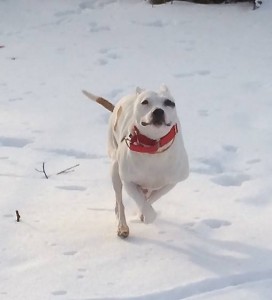
Electronic invoicing and payments have surfaced to slightly improve this laborious process. This puts less strain on clients (i.e., more time to pay) while giving them payment flexibility (i.e., pay with e-payment, not check). However this requires dog trainers to sit in front of a computer after a long day’s work and send out invoices, which doesn’t even guarantee that payments will be made on time (or at all).
PocketSuite – The Best Dog Training Business Mobile Payment App
Technology has evolved once again! Tools like Square and Venmo allow dog professionals to accept payments and credit cards from their phones while offering convenience to their clients. More advanced apps, like PocketSuite, even allow clients to reserve sessions and appointments upfront with credit card, enabling trainers to process payments while walking out of each session without hassling the client one bit.
Mobile payment apps as a whole offer core benefits compared to what you might be stuck using today, which in turn will help you run a more successful pet professional business.
Fast
Do work, get paid. That’s how mobile payment apps drive business – disrupting traditional invoicing so there’s no cumbersome process or ongoing game of “chase-and-remind” for clients who are late on payment. QuickBooks’ reign of clunky/desktop invoicing is over. Mobile and instantaneous payment methods free up dog trainers to put their time where it counts – on their actual skillset. With extra time on your hands, you are free to complete more sessions and win more clients.
Affordable
Typically, dog trainers who wanted to accept credit and debit card payments had to invest in a merchant processor account. These accounts come riddled with extra fees (e.g., gateway fees, monthly minimum fees, statement fees) totaling between $25 to $35 per month. But now mobile payment options give you the ability to process credit card transactions without the infrastructure of a merchant processor account. Such mobile payment options free you from long-term contracts and numerous hidden fees, offering clear pricing and fast deposits for a fraction of the cost. And the best ones come without any hardware at all.
Convenient
That’s convenience for both you and your clients. While you’re enjoying a life without invoicing and waiting for payments, your clients will enjoy a life with a lot less check writing, cash withdrawing and wallet opening. It’s freedom for both parties. At the same time, mobile payment apps can protect trainers from canceled jobs and client no-shows, by securing customer credit cards upfront when reserving appointments, all the while delivering clients an “Uber-like” experience.
Mobile payment apps flat out just make life easier for today’s pet professional. Dog trainers in particular will find that this independence, flexibility and support that these apps give them when running a business, will yield them more time and money – to help drive their business towards success.
Click the following link ON YOUR MOBILE device to sign up for this signature edition.
https://pocketsuite.io/register/modern-dog-trainer
![Guest Post: A Passion for Primitive Dogs]()
by Erin Bessey | Sep 16, 2015 | Training Methods
I live with a dog that has PICA. I am here to tell you that when a client says their dog eats rocks, sticks, just about everything, address it like it is PICA instead of it’s a puppy who will outgrow it. I never had experienced this disease until I got my second household dog, Henry, and he will eat anything! This disease can be life threatening and the added challenge for me was Henry had a secondary cleft palate so depending on what he ate it had the chance of going up into his nasal cavity. Here are 5 behaviors that I have found helpful in dealing with a dog with PICA.
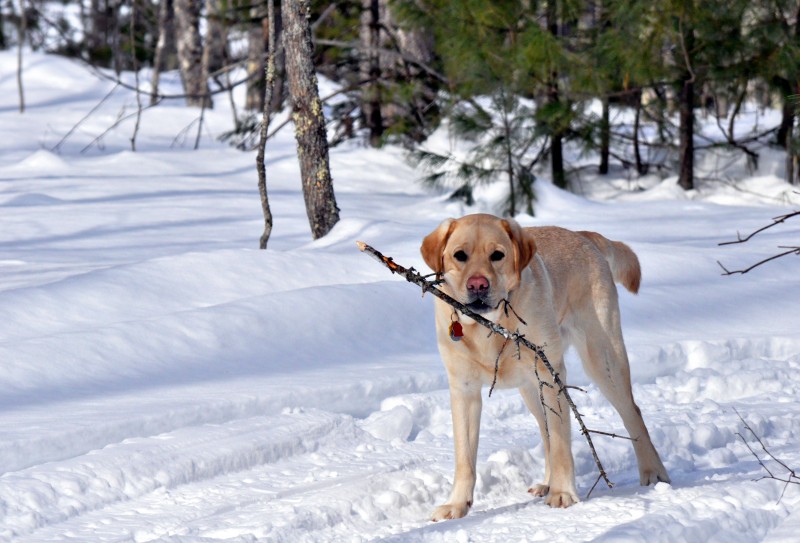
Image via Erin Bessey – Bessey’s Positive Paws
This behavior is important so that your dog responds to you when you call his name. It also works to gain your dog’s attention so that you can then cue him for another behavior. Using an actual interrupter noise or attention noise like a kissy sound will work to get your dog to focus on you. This is sometimes a better choice than name response because it is easy to abuse their name by over using it. Both the name response and the attention noise should be charged using a very high value, delicious treat.
Leave it
Once your dog is focused on you, you can then cue him to leave the item he is thinking about eating. This will be one of the most crucial behaviors to train. It does require you to be present with the dog who wants to eat everything but it is possible that the use of leave it over time will help decrease the intensity of the behavior. While Henry still eats things or tries to eat things he shouldn’t, it has improved over the past 3 years.
Drop It
There will be times when the dog is able to pick up something it shouldn’t and it is crucial to have a fast drop it to prevent him from eating it further.
Coming When Called
If you trust the dog off leash because you have worked hard on teaching the leave it cue, a reliable recall is another essential behavior. Even inside the house recall can work in your favor. If the dog is considering eating something leave it works to stop the behavior and then calling your dog back to you moves him further away from the object.
In the end this is one of the most important behaviors to teach. Teach the dog with PICA to accept wearing a basket muzzle. This allows the dog to have freedom with you outside without being restricted to a leash and allows the dog to be a dog. I would not advise using a muzzle in a heavily dog populated area when your dog is off leash as it does restrict your dog’s natural way of defending himself. This is also important to use when you have a reliable recall.
It is difficult and frustrating to be an owner of a dog with PICA. Management is crucial in preventing unwanted chewing and eating of objects. Having food dispensing toys, nyla bones, raw meat bones, etc. available to your dog will help satisfy some of the chewing desires. You never know what a dog with PICA is going to chew next so keeping a house cleaned of small items like socks and small kids toys will help. Crating the dog when you are unable to supervise will help prevent the undesired behaviors and keep your dog safe. Be certain to keep the crate free of blankets and only provide toys that have been proven to stand up to the chewing demands of your dog.
Get Dog Training Business Tips!
Receive valuable dog training business tips and resources every week! Subscribe to The Modern Dog Trainer now by submitting your name and email below.
[mc4wp_form]
![Guest Post: A Passion for Primitive Dogs]()
by TMDT Team | Sep 12, 2015 | Training Methods
Let’s face it. In the market place there are countless gadgets for trainers and dog-owners alike. However, over the years, I’ve found some of the best tools hiding away are in arms reach right at home. A skilled trainer has the ability to resource from the environment they are in; utilizing in-the-moment props if you will. Here are a few of my favorites to get you, the trainer to think on the spot.
Peanut Butter Club
Regardless of the high value treat, sometimes when our pups are small and our humans are tall it equals fumbling and tripping in attempt to “work at the same level”. For example if the small pup has to jump to reach the treat, without knowing, we’d be rewarding the jump itself. Much of the time especially with small dogs in the beginning, there can be fumbling with the treat pouch, working with the leash, and lowering down; that all of these moving parts end up leaving us delayed in the delivery of the treat, and can be confusing to the pup. My solution? The PBC, or the Peanut Butter Club. Fancy for a long wooden spoon laden with gooey delicious peanut buttery goodness. Find your longest wooden spoon, (or keep an eye out at your next yard sale) and coat the magic wand with your favorite peanut butter and send it to the freezer so it’s ready for rewarding the pup for polite leash walking. Remember to allow the pup to lick using the same arm as the side he’s on so they’re not being rewarded for crossing in front of the human! PBC is also a great tool when working with a fearful dog because the PBC is longer and will allow a shy dog to come closer. I often find that after a few trials I can shorten the spoon causing the fearful pup to come closer.
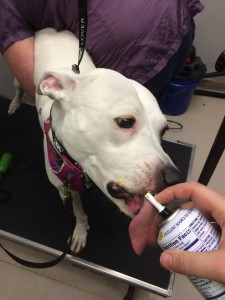
Say Cheese
In the Wild West the cowboys kept their pistols right on their side for quick access and total readiness. We as dog trainers need a fast treat delivery system if we want to pair our reward with the behavior. For this one, I’ve got good ol’ cheddar spray cheese in my holster. Although it’s not the healthiest of treats, dogs love it! You can grab the can along with other treats and hit the road. My favorite use for it is during the winter months because it keeps my hands covered and warm and so I can train the pups without getting frostbitten.
Let the Light In
Sometimes visual barriers are all that’s required for pups that struggle with perimeter barking and sensitivity to movement near or around the house. But, who wants to live in the dark; keeping curtains and front doors always closed? Not me! Encourage your client to consider a great product originally intended for bathrooms and privacy: Frosted clings for windows! I love to use them at front windows and the like, to take away the visual stimulation or trigger without causing the house to feel like a dungeon.
This step can be critical for dogs that don’t need to be crated but struggle with barking.
Not Intended for a Rainy Day
Maybe the most unassuming tool I keep in my training bag is an umbrella. But not just any umbrella: it’s got to be one that pops open at the touch of a button and is dark color to create an instant barrier. A while back I received a call from an elderly woman who had been out for a walk when an off leash dog ran up and attacked her little Maltese. Although the altercation was minor, it left the woman and her pup quite shaken. I suggested to her that she could consider carrying an umbrella, a mobile shield of sorts that would be available at the touch of a button to both shield her pup and keep him invisible on the other side. If a dog is approaching and there is concern, an umbrella can be dispatched and buy the human precious moments to get a hold of the situation on the street, or even in an elevator! Let’s face it: training takes place on every terrain, and I know that when working in urban environments triggers can lurk around every corner, which can really set back any good training protocol. With the umbrella you can limit the time the dog is reacting and get to a safer spot on your walk or step between cars and block the small space between cars with the open umbrella.
Since necessity is the mother of invention, what are some of your cool household tools?
Get Dog Training Business Tips!
Receive valuable dog training business tips and resources every week! Subscribe to The Modern Dog Trainer now by submitting your name and email below.
[mc4wp_form]
 My husband and I share our home with 5 Shiba Inus, a Cattle Dog mix, a Tibetan Mastiff, and a New Guinea Singing Dog. This seems like quite the mix of dogs, but they have one very strong thing in common and that is their primitive nature. To be clear, what I mean when I say “primitive dog” is a breed of dog who’s ancestral primitive nature is still intact. These dogs weave through the traditional breed groups making a pretty tapestry of shapes, sizes, and histories. But when you break them all down, a similar independent, sensitive, wise old soul is back there, ready to tell you that they know better. Some examples of primitive dogs are Africanis, Akitas, Alaskan Malamutes, Armenian Gampr, Basenji, Canaan Dog, Carolina Dog, Chow Chow, Finnish Spitz, Norwegian Elkhound, Pharaoh Hound, Saluki, Samoyed, Shar-pei, Swedish Lapphund and this is just a few. This short list (A longer list is available at the end of this article) gives you an idea of the variety of shapes, sizes, and jobs these dogs have, and their close resemblance to their canine ancestors, and/or selective breeding that has maintained behavioral and physiological traits going back 1000-5000+ years.
My husband and I share our home with 5 Shiba Inus, a Cattle Dog mix, a Tibetan Mastiff, and a New Guinea Singing Dog. This seems like quite the mix of dogs, but they have one very strong thing in common and that is their primitive nature. To be clear, what I mean when I say “primitive dog” is a breed of dog who’s ancestral primitive nature is still intact. These dogs weave through the traditional breed groups making a pretty tapestry of shapes, sizes, and histories. But when you break them all down, a similar independent, sensitive, wise old soul is back there, ready to tell you that they know better. Some examples of primitive dogs are Africanis, Akitas, Alaskan Malamutes, Armenian Gampr, Basenji, Canaan Dog, Carolina Dog, Chow Chow, Finnish Spitz, Norwegian Elkhound, Pharaoh Hound, Saluki, Samoyed, Shar-pei, Swedish Lapphund and this is just a few. This short list (A longer list is available at the end of this article) gives you an idea of the variety of shapes, sizes, and jobs these dogs have, and their close resemblance to their canine ancestors, and/or selective breeding that has maintained behavioral and physiological traits going back 1000-5000+ years.



 Coren began paying attention after a dog trainer mentioned that he noticed his dogs almost exhibited pushy, “dominant” behavior when they started to catch on to a new behavior. Instead of lolling tongues and wagging tails, the ears would go forward and tails up.
Coren began paying attention after a dog trainer mentioned that he noticed his dogs almost exhibited pushy, “dominant” behavior when they started to catch on to a new behavior. Instead of lolling tongues and wagging tails, the ears would go forward and tails up.



















